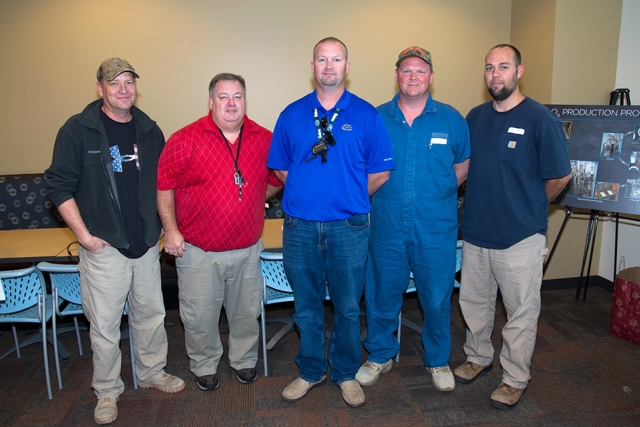
Picture the brightest lamp in your house — let’s assume it uses a 100 watt bulb — and think of the amount of heat it gives off if you hold your hand directly over it.
Now, picture 850,000 lightbulbs and the heat they would produce. Then cram all that energy — all 85 million watts — into a space as small as a household trashcan. That’s the concentration of power produced inside the High Flux Isotope Reactor at Oak Ridge National Laboratory.
And it wouldn’t be possible without Y-12’s uranium processing expertise.
Historically, Y-12 produces 80 kilograms of oxide feed material each year, which is sent to a facility in Lynchburg, Virginia, for fuel plate fabrication, although annual volume varies.
“This year, they asked us how much we could make, and we calculated we could produce 125 kilograms for them,” said Don Bible, Y-12’s HFIR project manager.
Y-12’s ability to meet HFIR’s needs is imperative.
Meeting those specifications is crucial to HFIR safely and reliably achieving its highly controlled nuclear reaction, which is used primarily to produce neutrons for research and discovery. During each HFIR cycle, beams of neutrons travel through tubes to adjoining research areas. There, they bombard any number of materials — from metals and plastics to liquid crystals and proteins — allowing researchers to see and understand them on an atomic level.
“Neutrons are a really good way to look inside materials,” David Renfro, HFIR nuclear engineer, noted.
“This can help us understand different materials and learn how they function, so we can use that knowledge to solve problems — from improving medications to building better batteries.”
Y-12’s Special Processing crew recently toured the HFIR facility to see their product in action. Before that trip, few understood HFIR’s unique capabilities or national importance.
“I knew our products went there, but I didn’t have a clue what it was for,” Chemical Operator Derek Chittum said. He added, “And I’ve been running this process for six years.”
Production Specialist Steve Watson organized the tour to provide a little extra motivation to a crew that worked many long days and weekends to deliver their mission.
“I wanted them to see first-hand what the long hours were for and what it truly meant,” Watson said.
On the tour, the operators saw the reactor pool, control room, and associated research facilities. They learned how the fuel plates are fabricated and how the lab welcomes users from around the globe to conduct studies at HFIR free of charge.
“It was a good tour. It’s very interesting to see the final product,” Andy Trentham, chemical operator, said. “Our product is going over there to help people research important things.”
Having the end in mind helped Y-12’s operators understand their own role in the process.
“It helps you appreciate what you do,” Chittum said. “The product we keep putting out keeps that reactor running. They’ve told us they couldn’t do it without us.”
That new appreciation for the work — and their vital role in it — inspired the crew to work overtime to meet the year’s deliverables.
“When we were asked if we thought we could make the commitment, the guys in the crew took it as a challenge,” Watson said of the 125-kilogram goal. “They didn’t hesitate. Their answer was, ‘We will make it.’”
For more information on the High Flux Isotope Reactor and its four primary research capabilities, visit their website.